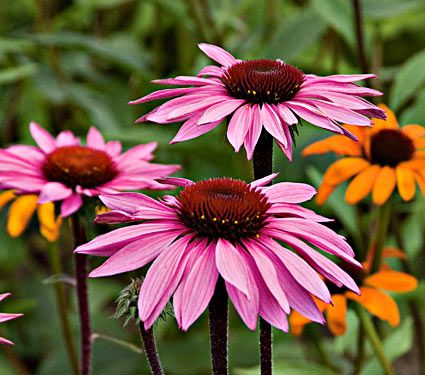






Coneflower: A Palette's-Worth of Summertime Color
Native to eastern and central North America, this virtually foolproof perennial (Echinacea spp.) offered gardeners little besides reliability until recently. In the last few years, however, plant breeders have released the beauty hidden within these rugged wildflowers, creating double-flowered Coneflowers, fragrant Coneflowers, and Coneflowers in an astounding palette of new and vivid colors.
Our Coneflower Selection
We've been growing and evaluating the newest Coneflowers in our trial gardens and are confident that those we've chosen to offer will invigorate any sunny border, meadow, or cottage garden. Blooming from late June until the first fall frost, these new, more-than-just-purple Coneflowers furnish a range of hues, from flamboyant tropical oranges to cool, sophisticated green or white. Best of all, we've found that their cosmetic makeover did not detract from these perennials' native hardiness. They flourish in ordinary soils and, once rooted in, are remarkably resistant to heat and cold as well as drought. Though they prefer full sun, they also perform satisfactorily in partial shade. You'll appreciate the versatility of our Coneflowers, which not only provide nearly foolproof, perennial garden color and fragrance but also long-lasting cut flowers. The bright blossoms are beloved by butterflies; the cones of seeds that remain after the petals drop attract goldfinches and other songbirds.
Coneflower Growing Tips
Echinacea -- How to Care for Your Plant
Light/Watering: Flowering is at its best in full sun, although plants will tolerate light shade. Deep taproots make these plants quite drought-tolerant once established.
Fertilizer/Soil and pH: Plants do not benefit from added fertilizer, especially if grown in partial shade. Echinacea purpurea is adaptable to most soil types but prefers a sandy, well-drained loam and a pH from 6.0 to 7.0.
Pests/Diseases: Echinacea is rarely troubled by pests or diseases, none serious enough to warrant control measures. Plants do attract beneficial insects, especially firefly-like soldier beetles, which feed on aphids and caterpillars.
Companions: Shorter perennials camouflage occasional basal legginess; compact varieties of Catmint (Nepeta) are ideal companions as are perennial Geraniums, dwarf Goldenrods (Solidago), and Salvia. Taller companion plants include Perovskia, Phlox, Sedum, Veronica, and Monarda.
Reflowering: Echinacea has a long bloom season even without deadheading, but that practice will result in more blooms. Plants can be cut back by half in early summer, resulting in a later bloom time but more compact form. Leave some seed heads to provide food for goldfinches -- there are few sights more delightful than watching the small, golden birds wave about as they pick out the seeds.
Dividing/Transplanting: Plants rarely need dividing, and transplanting older plants can be tricky due to the taproot. It can be done, however, as long as you dig deeply and keep a good amount of soil around the roots.
End-of-Season Care: Plants may be left standing through winter as the seeds heads collect the snow in pretty little puffs. If desired, cut back to the ground after a killing frost.
Calendar of Care
Early Spring: Divide or transplant now, watering well afterward.
Late Spring: Provide supplementary water only if the season is extremely dry or if the Coneflowers are newly planted.
Summer: Deadhead if desired, but leave some seeds for the goldfinches. Watch for beneficial soldier beetles in August and do not harm them. Plants may be cut back by half in June; this will result in later-flowering, more compact growth.
Fall: Plants may be cut back to the ground after a hard frost. A light mulch in colder regions is beneficial.
Copyright © www.100flowers.win Botanic Garden All Rights Reserved